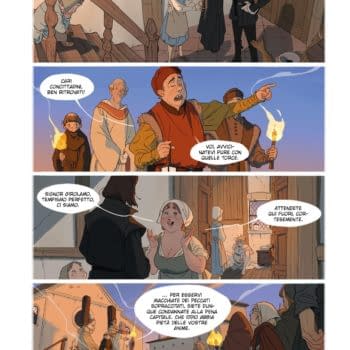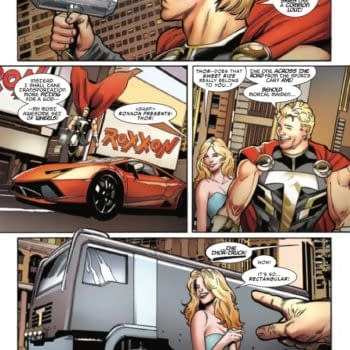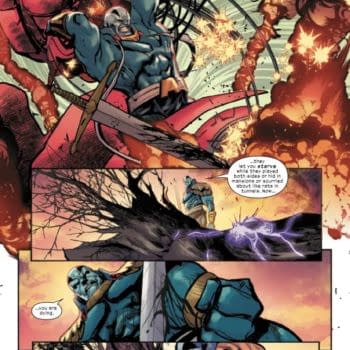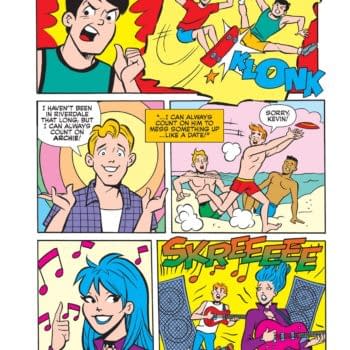Posted in: Comics, Recent Updates | Tagged: Anno Dracula, Comics, dave stewart, entertainment, horror, Kim Stewart, Maura McHugh, mike mignola, Sir Edward Grey: Witchfinder, Tyler Crook
An Eerie Eel Spectacular In Edward Grey: Witchfinder Vol. 3 – Talking With Maura McHugh And Kim Newman, Plus Free First Issue
Written by Maura McHugh and Kim Newman, with art by Tyler Crook, colors by Dave Stewart, and a cover by Mike Mignola, the third volume dedicated to stories from the life of Sir Edward Grey: Witchfinder arrives in comic shops this week on April 22nd, and is hitting the bookshops next week. This arc, titled "The Mysteries of Unland" sends Grey to the marshes of Hallam where he, of course, discovers terrifying things that may expose you to the most horror imagery dealing with eels that you've yet seen, but also takes readers further into the world of Sir Edward. As McHugh and Newman allude to in the discussion below, it's remarkable how little we know about the stalwart man between the different established points in his life, death, and afterlife. In keeping with many characters generated within the Mignolaverse, Sir Edward can be examined as a work in progress even though we may think we know his "fate".
In fact, it was Mike Mignola who was a particular fan of Kim Newman's prose work Anno Dracula, also set within the Victorian period, and suggested a project dealing with Grey. Both McHugh and Newman are expert in the horror genre and they are joined by Tyler Crook, whose highly nuanced upcoming work in Harrow County from Dark Horse is well worth looking out for. Together they form a creative team of a caliber worthy of the man and the legend that is Sir Edward Grey.
Maura McHugh and Kim Newman join us today to talk about Grey's appeal, "The Mysteries of Unland", and what works best in comics to convey horror:

Maura McHugh: Sir Edward discovered supernatural creatures existed when he was young, and spent his life protecting people from the more malign effects of those entities. He became an occult detective, and at our point in Sir Edward's career he is a special agent for the crown (Queen Victoria).
Kim Newman: My touchstone for writing Sir Edward here was that he'd been through the events of the earlier miniseries and was on his way to his established death and post-mortem activities, and we needed to see him changing from the person he was into the person he will be – but not too much, since there are long stretches of his story not yet filled in. To give the man we're with on this adventure a bit of a specific mood, we gave him a job that at first seems beneath him and made him initially impatient with it…he knows he lives in a world with giant monsters and ancient magic, so he's as pleased to be asked to look into the case of someone who drowned in a bath as, say, Dr. Strange would be if you asked him about your back-ache. But he's also a very clever man, and very clever men like to show it…so even before the big magic picture becomes apparent, he starts to enjoy being a detective.

MMcH: I've written 19th century characters before, and it's a time period that's very sympathetic for horror stories. That century produced memorable narratives, from the high Gothic fiction at the start of the 1900s all the way to the weird, unsettling stories created the end of the era.
It's fun to tap into these literary horror traditions of Victorian England as well as considering the fears and obsessions of the people living during that time.
KN: I know that Mike Mignola read my novel Anno Dracula, which is set in London in 1888, and that was what put my name in his head with regards to this character. I've used a lot of historical settings – especially 19th and 20th century – and am comfortable writing about it. There were some Victorian-Edwardian writers who wrote the kind of material that informed the Lovecrafty/Weird Tales vibe from which the whole Hellboy universe springs – everyone suddenly knows who Robert Chambers is, but see also Arthur Machen, William Hope Hodgson. For this particular story, and its setting, I thought a bit about other 19th century sources – Hardy, Dickens. Getting out of London and to the West Country was also a useful change.

MMcH: The marsh environment of Unland offers a new, liminal space for Sir Edward to investigate, and a group of people, and monsters, that are particularly British.
KN: I suspect that with this volume, you can start thinking of a Grey series as opposed to a miniseries with a sequel. We worked a bit on his supporting cast, inventing a new character and naming one or two others. We've still not seen much of Grey in a professional context outside of a few trips to the morgue. Off the top of my head, I can't remember if we've ever seen where he lives – I assume he has a house in London rather than rooms (a knighthood and patronage suggests some money), but he might have a country place we've not visited yet. He has no surviving love interest or significant relatives – though if it were up to me, I'd keep it that way (I'm bored with murdered/martyred/fridged parents and lovers as comic book motivators). The Unland mythology dovetails with the frogs business in other Mignolaverse titles, but is new with us – if other creators want to use any of it (even if it just means leaving empty bottles of Poole's Elixir lying about) then we'd be delighted.
HMS: So much good horror fiction ties into geographical locations, I've noticed, and the more firmly anchored, often the better the story works. How did you delineate the setting and geography of Unland, and were there any real-world inspirations or traditional folk stories that inspired you?
MMcH: While Unland and the town of Hallam may not exist in reality, they are very much based on actual locations, and the tradition of the industrial town created by 19th century entrepreneurs. The life cycles of eels, and the tendency of the area to flood also gave us some ideas.
KN: I grew up in Somerset, where a few towns like Hallam (Street, for one) were built around one industry (chocolate, shoemaking) in the 19th century, with the intent of improving the lives of the workers – in the story, we show some of the more annoying sides of this but the people who came up with the idea were generally social reformers who did a lot of good. Also in Somerset is Glastonbury, which has several ancient sites (Glastonbury Abbey, Glastonbury Tor) associated with several religions. The county was once marshland – mostly drained in the 18th and 19th century, whereupon islands became villages. It floods regularly and while we were working on the comic there were some spectacular floods, perhaps exacerbated by new development and neglect of waterways. We sent Tyler [Crook] some photographic references of this. Fishing for eels ('elvering') is a Somerset tradition, and there are some ritualistic elements of that. I also sent Tyler photo sources for what the levels look like – the Poole house is on top of an artificial hill, like Burrow Mump or Glastonbury Tor.

MMcH: Most people know when they are reading horror that unusual events may take place, so a certain license has been given to the author at the beginning. It's important not to squander that.
The trick is to ease the reader in with believable characters who are reacting honestly to strange circumstances. For comics, it helps when the art is evocative – at turns mysterious and gory when required.
KN: Like Maura says, it's the people. I almost always start with the people…though, here, the landscape was important too. I especially like scenes where two or three or more people talk at cross-purposes and stuff is going on that only the reader notices. There are things you can do in comics that you couldn't in a book or a movie – the telling background detail, in particular.

MMcH: I enjoyed bringing a bit of humour into Sir Edward's world, and giving him some new characters for allies and antagonists. I thought issue 4 turned out particularly well, which was hugely helped by the excellence of Tyler's art and Dave [Stewart's] colouring.
KN: I loved the Suspicions of Constable George Lawless spread, with its reference to Victorian sensationalist illustration – and also the chance to do something a bit different in comics storytelling (I've said that if DH ever want to do a one-shot in this style, I'd be up for it.). And I was particularly pleased with the panels where we find out what really happened to the original Hallam. Oh, though we went back and forth on it a bit, I'm proud of the paraphrase of Bob Dylan's 'I don't need a weatherman to tell which way the wind blows' at the end of issue two.

MMcH: I've a short comic book tale coming out in a forthcoming anthology as well as some more short stories and essays – plus several other projects in development which I can't discuss currently. I'd be happy to write some more adventures for Sir Edward!
KN: I've just finished a draft of a novel, Secrets of Drearcliff Grange School, for Titan Books. I'm already pondering two more – Angels of Music (which is loosely a riff on The Phantom of the Opera and Charlie's Angels) and an as-yet-untitled Anno Dracula novel set in Japan. I'm just beginning a hush-hush comics project too. I'd certainly consider coming back.
Big thanks to Maura McHugh and Kim Newman for joining us here today to talk about Sir Edward Grey, and here's our free first issue of "The Mysteries of Unland":















